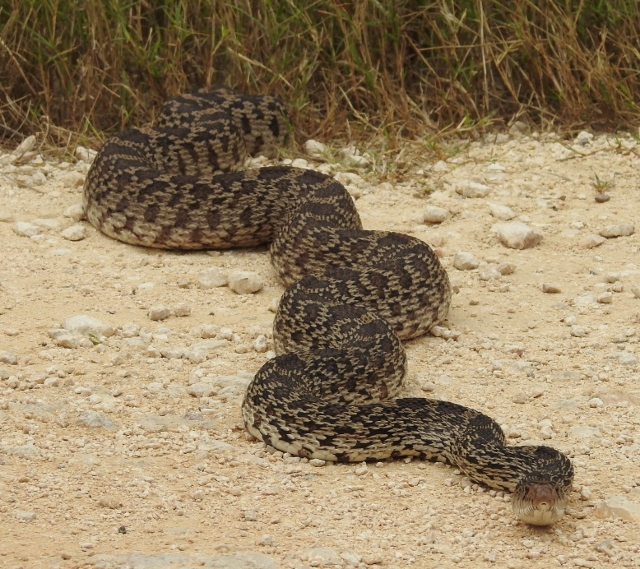by M. Kathy Raines

Unable to ignore our blue heeler’s fervent barking, I peered outside. A long, plump snake, creamy with dark blotches, glided towards our glass door, its tail just beneath the fence. Shoving the dog inside, I locked the door—as if the snake might slide it open.
I thought it a rattlesnake, but its tail, which soon appeared, held no rattles. A quick search in World Book—these being pre-Internet days—revealed it was a bull snake (Pituophis catenifer sayi). So, I called Gladys Porter Zoo, mistakenly thinking personnel might like to pick it up. “Oh, congratulations!” said the voice on the other end. “You have a wonderful snake to eat your rodents!”
Hating to spurn nature’s gift, I feared the snake might hurt my children or dog. So, my neighbor and I stuffed it—hissing and lunging— into an empty garbage can, which he and I, along with a trail of children, ceremoniously marched down to a vacant lot where we poured it out to feast upon rats and mice in peace.
Unfortunately, many a beneficial bull snake loses its life to a shovel or a gun when mistaken for the equally thick-bodied western diamondback rattlesnake (Crotalus atrox)—not that people should harm any non-threatening snake. At Laguna Atascosa recently, I again mistook a bull snake— head raised, its body a thick, moving braid—for a rattler. Thankfully, a herp-aficionado hastily corrected me when I misidentified it on Facebook.
Though bull snakes and rattlesnakes are in different families, Colubridae and Viperidae, respectively, they share similar shapes, markings and habitat. Also, some bull snake behaviors mimic those of rattlesnakes.
While a bull snake’s head is narrow, appearing indistinct from its neck, a rattlesnake’s is triangular. However, a frightened bull snake may flatten its head to mimic a rattler’s. Also, a bull snake has round pupils, whereas a rattlesnake’s are vertical slits. Bull snakes, of course, lack the heat-sensing pits between eyes and nostrils characteristic of pit vipers.
Though they share habitat, bull snakes, unlike rattlers, are daytime eaters who, since they constrict prey rather than envenomate creatures individually, can efficiently devour an entire nest of rodents. Unlike rattlesnakes, who ambush prey, bull snakes primarily forage, crawling around, inspecting loose soil and creatures’ dens with their noses, eating mice, rats, squirrels, rabbits, lizards and insects. Adept climbers, they ascend trees to rob nests of eggs and hatchlings. Contrary to legend, they seldom eat rattlesnakes.
Like a rattlesnake, a wary bull snake may gather itself into an S-shape. Also, its flexible epiglottis vibrates as it breathes, creating a “growl mixed with classic hissing,” according to Gladys Porter Zoo reptile keeper Mitch Wehrle—a sound easily confused with rattling. It also rustles its tail in dry leaves, mimicking a rattle. A bull snake holds its pointed tail downwards, while a rattlesnake lifts its rattled tail.
A bull snake, a subspecies of gopher snake, is generally khaki-colored with brownish or black blotches and a light yellow chin and belly with mottled rectangles. Its head has a slight sideways ridge suggestive of a bull’s horn, inspiring its name. Dark lines run from its eyes to jaw angles, and its rostral scale—that on the tip of its snout—is elongated, giving its head a pointed shape. Its scales are heavily keeled or ridged. Among the longest North American snakes, a bull snake can exceed eight feet.
Bull snakes thrive in fields, grasslands, deserts and some wooded areas in the Rio Grande
Valley. They also frequent golf courses and suburban areas. Once, a German shepherd and I spent twenty minutes watching a motionless, outstretched bull snake staring at a likewise motionless cottontail in a Harlingen front yard; we departed prior to the drama’s denouement.
Bull snakes range from southwestern Canada down through the Great Plains, through the middle of Texas and into Mexico. While plentiful here, they appear to be declining in the upper Midwest, along with diminishing grasslands.
In springtime, a female bull snake lays down a trace of pheromonal scent to attract a mate, and males fight for the privilege of mating. She eats substantially to assure she has adequate energy for egg-production. Employing an abandoned burrow or digging a hole in loose soil under a rock or log, she lays, then covers up, from 3-24 sticky, leathery, calcified eggs. Hatchlings, which emerge in early fall, depart immediately and mature at about two.
A bull snake, though full of bluster, rarely strikes a person unless harassed, and then its habit is to rear up, hiss and lunge—occasionally biting, but often head-butting with mouth closed—then retreat. Bull snakes do not chase, and they rarely bite. Not particularly speedy, they cross and bask upon highways, sometimes being crushed under wheels.
Valued for their robustness, bull snakes are popular pets which are bred for a variety of colors. They can be feisty, but regular handling when young may foster gentleness and docility. Not recommended as a beginner’s snake, Reptile Magazine calls the challenges of caring for them “intermediate”.
During cold winters, these snakes, being cold-blooded and unable to regulate their body temperatures, may brumate, which is akin to a mammal’s hibernating, but snakes may emerge to eat, drink or bask in the sun. They brumate in rotten logs, crevices, woodpiles or burrows, sometimes even in abandoned wells or houses, often with other species.
Clint Guadiana, Curator of Reptiles and Amphibians at the Gladys Porter Zoo, said, “I wouldn’t consideration brumation a ‘thing’ down here,” since winter temperatures fluctuate so much. “Snakes definitely slow down during the winter,” he said, “but are by no means inactive.”
Since these snakes negate the need for rodent control, farmers love having a bull snake loose in their barns. We are indeed fortunate that these benign, beautiful snakes live among us.
